|
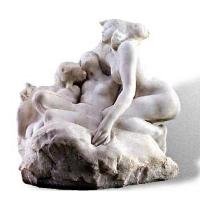 'The
Sirens' shows three entwined female figures kneeling and sitting on a
piece of rock. According to Greek mythology, these sisters lived on
three small rocky islands, the Sirenum Scopuli. According to Ovid,
the nymphs failed to prevent the abduction of their playmate Persephone by
Hades. To punish them, her mother Demeter changed them into birds with
female faces. 'The
Sirens' shows three entwined female figures kneeling and sitting on a
piece of rock. According to Greek mythology, these sisters lived on
three small rocky islands, the Sirenum Scopuli. According to Ovid,
the nymphs failed to prevent the abduction of their playmate Persephone by
Hades. To punish them, her mother Demeter changed them into birds with
female faces.
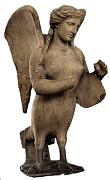 Ancient
authors like Sophocles, Homer, Hyginus, Apollonius Rhodius, Tzetzes and
Apollodorus differ as to their exact number (two, three or four), their
proper names (Parthenope, Leucosia and Ligia, or Pisinoe, Aglaope and
Thelxiepia, or rather Teles, Raidne, Molpe and Thelxiope), the true
identity of their parents (Phorcys & the Muse Melpomene, or the storm
god Achelous & the Muse Terpsichore), and the way they received their
wings - when any. Ancient
authors like Sophocles, Homer, Hyginus, Apollonius Rhodius, Tzetzes and
Apollodorus differ as to their exact number (two, three or four), their
proper names (Parthenope, Leucosia and Ligia, or Pisinoe, Aglaope and
Thelxiepia, or rather Teles, Raidne, Molpe and Thelxiope), the true
identity of their parents (Phorcys & the Muse Melpomene, or the storm
god Achelous & the Muse Terpsichore), and the way they received their
wings - when any.
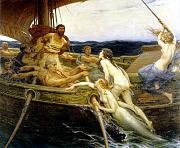 But in all narrations, the Sirens were mentioned for
their seductive songs, with which they lured unsuspecting sailors to the
dangerous rocks. The smart Odysseus, however, had the ears of his crew sealed
with wax and himself tied to the mast of his ship, to stop him from following their
lethal invitation.
But in all narrations, the Sirens were mentioned for
their seductive songs, with which they lured unsuspecting sailors to the
dangerous rocks. The smart Odysseus, however, had the ears of his crew sealed
with wax and himself tied to the mast of his ship, to stop him from following their
lethal invitation.
Rodin's sculpture depicts their sinuous bodies connected
by their outstretched arms and long, undelating hair - a formal echo of
the waves that surround them. Like many other works associated with the
watery element - such as 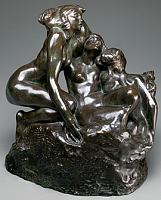 the 'Danaid' and 'Andromeda' - the aqualine
shapes provide the figures with a polished sensuality and sweetness,
which stands in strong contrast to their dramatic situation or malicious character. the 'Danaid' and 'Andromeda' - the aqualine
shapes provide the figures with a polished sensuality and sweetness,
which stands in strong contrast to their dramatic situation or malicious character.
In 'The Sphinx' (1886) and
its later variation 'The Succubus' we
recognize the dominating female character kneeling on the left side. As a
group, 'The
Sirens' appear for the first time on the lower left leaf of the 'Gates of
Hell'; later the composition was worked out as an independent work, shown at the 1889
Rodin-Monet exhibition, together with both versions of 'The
Sphinx'.
Finally, Rodin made use of the three sisters again in the final version of the second 'Victor Hugo Monument'
('Apotheosis of
Victor Hugo'), where they can be found in a tilted position at
the base of the pedestal,
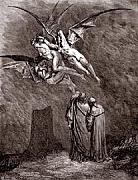 and
in 'the Death of the Poet', placed on the tympanum of a maquette for a
fireplace [Grappe, no. 198] and
in 'the Death of the Poet', placed on the tympanum of a maquette for a
fireplace [Grappe, no. 198]
Michelle Facos already pointed out that 'The Sirens' do
not occur as such in Dante's 'Divine Comedy'.
Aida Audeh, however, tries to trace
the origin of the three sisters to Canto IX of Dante's 'Inferno', where
Dante, approaching the city of Dis, encounters the three Furies, who
threaten him with their serpent-like hair: Guarda", mi disse, "le
feroci Erine. Quest'è Megera dal sinistro canto; quella che piange dal destro è Aletto;
Tesifòn è nel mezzo"
|
Where in a moment saw I swift uprisen
The three infernal Furies stained with blood,
Who had the limbs of women and their mien,
And with the greenest hydras were begirt;
Small serpents and cerastes were their tresses,
Wherewith their horrid temples were entwined.
And he who well the handmaids of the Queen
Of everlasting lamentation knew,
Said unto me: "Behold the fierce Erinnys.
|
This is Megaera, on the left-hand side;
She who is weeping on the right, Alecto;
Tisiphone is between;" and then was silent.
Each one her breast was rending with her nails;
They beat them with their palms, and cried so loud,
That I for dread pressed close unto the Poet.
"Medusa come, so we to stone will change him!"
All shouted looking down; "in evil hour
Avenged we not on Theseus his assault!"
|
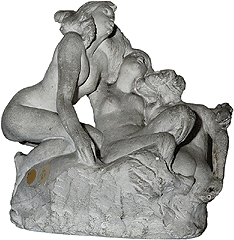 According to this
argument, Rodin has included the three enchanting girls at the waterside in
lieu of the three winged allies of the petrifying Medusa. According to this
argument, Rodin has included the three enchanting girls at the waterside in
lieu of the three winged allies of the petrifying Medusa.
The group is known in different sizes and materials: marble versions are exhibited in the Montreal Museum of Fine Arts,
The Cleveland Museum, the Ny
Carlsberg Glyptotek, Copenhagen, Denmark and in the Thiel Gallery,
Djurgarden, Stockholm; bronze versions can be seen in the Fine Arts Museum
in Budapest, the NGA in Washington and in the National Museum of Western
Art,Tokyo. The Rodin Museum of Philadelphia and the Musée Dr. Faure in
Aix-les-Bains each own both a plaster and a
bronze version.
Bibliography provided by NGA:
 Geffroy, Gustave. "A. Rodin." La Justice (19 May 1887).
Geffroy, Gustave. "A. Rodin." La Justice (19 May 1887).
 Bartlett, Truman H. "Auguste Rodin, Sculptor." American Architect and Building News (19 January-15 June 1889): 225.
Bartlett, Truman H. "Auguste Rodin, Sculptor." American Architect and Building News (19 January-15 June 1889): 225.
 Grappe, Georges. Catalogue du Musée Rodin. Paris, 1927: 63. Grappe, Georges. Catalogue du Musée Rodin. Paris, 1927: 63.
 Grappe, Georges. Catalogue du Musée Rodin. 5th ed. Paris, 1944: 67.
Grappe, Georges. Catalogue du Musée Rodin. 5th ed. Paris, 1944: 67.
 Spear, Athena Tacha. Rodin Sculpture in the Cleveland Museum of Art. Cleveland, 1967: 8, 60-61, 64, 99.
Spear, Athena Tacha. Rodin Sculpture in the Cleveland Museum of Art. Cleveland, 1967: 8, 60-61, 64, 99.
 Tancock, John. The Sculpture of Auguste Rodin. Philadelphia, 1976: 215-219. Tancock, John. The Sculpture of Auguste Rodin. Philadelphia, 1976: 215-219.
 Roos, Jane. Rodin, Hugo, and the Pantheon: Art and Politics in the Third Republic. Ph.D. diss., Columbia University. Ann Arbor, Michigan, 1981: 651-652.
Roos, Jane. Rodin, Hugo, and the Pantheon: Art and Politics in the Third Republic. Ph.D. diss., Columbia University. Ann Arbor, Michigan, 1981: 651-652.
 Beausire, Alain. Quand Rodin Exposait. Paris, 1988: 105, 125, 131, 148, 157, 178, 181-182, 211, 233, 251, 255, 330.
Beausire, Alain. Quand Rodin Exposait. Paris, 1988: 105, 125, 131, 148, 157, 178, 181-182, 211, 233, 251, 255, 330.
 Fonsmark, Anne Birgitte. Rodin: La collection du Brasseur Carl Jacobsen à la Glyptothèque. Copenhagen, 1988: 122-123.
Fonsmark, Anne Birgitte. Rodin: La collection du Brasseur Carl Jacobsen à la Glyptothèque. Copenhagen, 1988: 122-123.
 Rosenfeld, Daniel G. Auguste Rodin's Carved Sculpture. Ph.D. diss., Stanford University, 1993: 470-474.
Rosenfeld, Daniel G. Auguste Rodin's Carved Sculpture. Ph.D. diss., Stanford University, 1993: 470-474.
 Sculpture: An Illustrated Catalogue. National Gallery of Art, Washington, 1994: 207, repro.
Sculpture: An Illustrated Catalogue. National Gallery of Art, Washington, 1994: 207, repro.
 Porter, John R., and Yves Lacasse. Rodin à Québec. Quebec, 1998: 154-155.
Porter, John R., and Yves Lacasse. Rodin à Québec. Quebec, 1998: 154-155.
 Butler, Ruth, and Suzanne Glover Lindsay, with Alison Luchs, Douglas Lewis, Cynthia J. Mills, and
Jeffrey Weidman. European Sculpture of the Nineteenth Century. The Collections of the National Gallery of Art Systematic Catalogue. Washington, D.C., 2000: 354-357, color repro. Butler, Ruth, and Suzanne Glover Lindsay, with Alison Luchs, Douglas Lewis, Cynthia J. Mills, and
Jeffrey Weidman. European Sculpture of the Nineteenth Century. The Collections of the National Gallery of Art Systematic Catalogue. Washington, D.C., 2000: 354-357, color repro.
|
 'The
Sirens' shows three entwined female figures kneeling and sitting on a
piece of rock. According to Greek mythology, these sisters lived on
three small rocky islands, the Sirenum Scopuli. According to Ovid,
the nymphs failed to prevent the abduction of their playmate Persephone by
Hades. To punish them, her mother Demeter changed them into birds with
female faces.
'The
Sirens' shows three entwined female figures kneeling and sitting on a
piece of rock. According to Greek mythology, these sisters lived on
three small rocky islands, the Sirenum Scopuli. According to Ovid,
the nymphs failed to prevent the abduction of their playmate Persephone by
Hades. To punish them, her mother Demeter changed them into birds with
female faces.
 Ancient
authors like Sophocles, Homer, Hyginus, Apollonius Rhodius, Tzetzes and
Apollodorus differ as to their exact number (two, three or four), their
proper names (Parthenope, Leucosia and Ligia, or Pisinoe, Aglaope and
Thelxiepia, or rather Teles, Raidne, Molpe and Thelxiope), the true
identity of their parents (Phorcys & the Muse Melpomene, or the storm
god Achelous & the Muse Terpsichore), and the way they received their
wings - when any.
Ancient
authors like Sophocles, Homer, Hyginus, Apollonius Rhodius, Tzetzes and
Apollodorus differ as to their exact number (two, three or four), their
proper names (Parthenope, Leucosia and Ligia, or Pisinoe, Aglaope and
Thelxiepia, or rather Teles, Raidne, Molpe and Thelxiope), the true
identity of their parents (Phorcys & the Muse Melpomene, or the storm
god Achelous & the Muse Terpsichore), and the way they received their
wings - when any.

 the
the 
 According to this
argument, Rodin has included the three enchanting girls at the waterside in
lieu of the three winged allies of the petrifying Medusa.
According to this
argument, Rodin has included the three enchanting girls at the waterside in
lieu of the three winged allies of the petrifying Medusa.